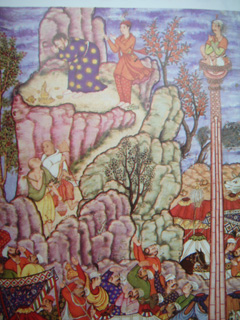This week’s picture is taken from a fabulous illuminated manuscript created for the sixteenth-century Mughal Emperor Akbar, which is currently the subject of an immensely entertaining exhibition at the Victoria & Albert Museum. The Hamzanama, as it is known, originally comprised a series of 1400 images illustrating a text of no less epic proportions, created over a period of 15 years by a veritable army of artists. Today only around 200 of the illustrations survive, widely dispersed across the globe. Like all the illustrations to Akbar’s Hamzanama the picture reproduced here is large, over two feet high, and exquisitely coloured, while the story it tells (more of which later) is characteristically complicated and packed with incident.
The Hamzanama, or “Story of Hamza”, chronicles the adventures of a partly historical and partly fictional character, Hamza ibn Abdul-Muttalib, the paternal uncle of the Prophet Muhammad, who travels the world spreading the teachings of Islam and doing battle with its enemies. Around the campfires of the Indian subcontinent, it seems to have been appreciated primarily as a cracking good yarn, or tangle of yarns. Spread orally, its main story line became richly embroidered with colourful sub-plots and digressions in which heroes confront sea monsters, sorcerors and evil warlords, rescue beautiful princesses and cunningly lure their enemies into all kinds of comical predicaments.
The precise details of the particular story illustrated in this particular picture are impossible to establish, because no complete text of the Hanzanama survives. But from fragmentary elements of the narrative scholars have pieced together the essentials of what is going on. Hamza’s principal spy, a comically resilient character called Umar, has been caught sneaking around the camp of the evil heathen ruler Malik Iraj, leader of a rogue Iranian sect of sun-worshippers. Knowing that Umar is a...


